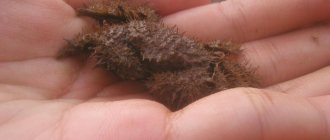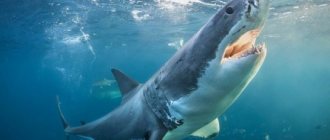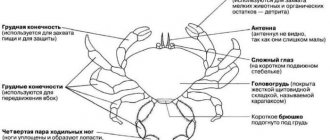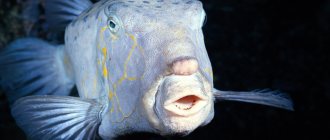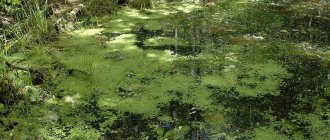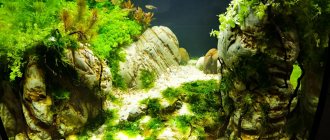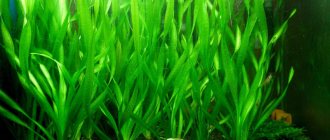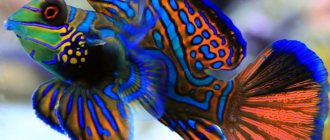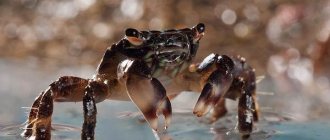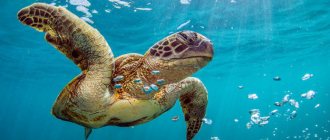Rapana
Rapan is a large carnivorous sea snail with a magnificent heavy shell, which many associate with numerous and very simple Black Sea souvenirs. You may be surprised to learn that rapana are not “indigenous” to the Black Sea, but were brought to us from the Pacific waters of the Far East and Asia! In fact, these predators only appeared in the Black Sea in the 1940s, transported on ship hulls.
PHOTO: avatars.mds.yandex.net
In addition to its exotic origin and status as a marine pest, in recent years, rapan has established itself as a popular seafood product along the entire Black Sea coast. Boiled and thinly sliced rapana is an excellent salad ingredient when combined, for example, with red onion, olive oil and a little lemon juice.
PHOTO: avatars.mds.yandex.net
If you are going to catch and cook rapana yourself, then follow these steps. Wash the shells and pour boiling water over them for a few minutes. After this, open and remove the shell flap, and then remove the body with a fork. Separate the edible portion of the white meat from the stomach and other innards, and then boil the meat for no more than 5 minutes. Add sea salt if possible.
Beneficial features
Arthropod meat contains a high concentration of beneficial active substances that make the body healthier and the person himself happier. The content of essential acids in crab is several times higher than that in fish and other seafood. These are: 80% moisture, 1.4% lipids, 19% protein, 2% ash, 2% glycogen.
Crabs are record holders for Sodium (Na) content.
Crab meat is considered a dietary product. Nutritionists advise including it in the diet of those losing weight and those who are watching their figure. But we should not forget about the dosage: meals consisting of seafood should not appear on the menu more than 3 times a week.
Due to the vitamin (taurine, tocopherol, ascorbic acid) and nutrient (polyunsaturated fatty acids, iodine, zinc, calcium) composition, the product is useful for anemia, deterioration of the organs of vision and cardiovascular pathologies.
What else is useful for crab meat:
- strengthens the heart muscle;
- reduces cholesterol levels in the blood and maintains its permanent indicator;
- protects the body from pathologies of the heart and blood vessels (serves as a kind of prevention);
- normalizes the level of thyroid hormones and improves the functionality of the endocrine system;
- promotes increased visual performance, combats the problem of dry eyes;
- improves the digestive system, “accelerates” metabolism and promotes better digestibility of foods;
- fights strong psycho-emotional stress, protects the nervous system from depression and anxiety;
- uplifts the mood and gives a feeling of peace;
- prevents premature aging of all body systems and skin;
- acts as an aphrodisiac and increases libido in both partners.
Use of the ingredient in cooking
Recipe for ravioli with crab and apples
We will need:
- drinking yogurt (milk-based without flavors and sweeteners) – 150 ml;
- Greek yogurt – 10 ml;
- gelatin – 1 sachet/piece;
- crab meat – 50 g;
- green apples (with a sour taste) – 40 g;
- avocado (choose ripe dark green fruit) – 1 piece;
- cream (any fat content) – 10 ml;
- cilantro (can be replaced with your favorite herbs) – 5 g;
- lemon or lime juice – 3 ml.
Preparation
Prepare gelatin according to the instructions on the package (depending on the specifics of the gelatin). Mix the prepared gelatin with drinking yoghurt, mix the ingredients until you get a homogeneous liquid mass. Prepare a baking sheet: line it with parchment paper and spread the gelatin-yogurt mixture evenly over it. Place the baking sheet in a dry, dark place until the mixture hardens. As soon as the gelatin has set and the yogurt has hardened, cut out circles from the frozen plate. The size of the circle depends on the desired size of the ravioli.
Grind half the avocado in a blender, then pour in the cream. Place the resulting mousse in the refrigerator. Grind the other half of the avocado and mix with chopped crab meat, herbs and apples. Season the apple-meat salad with lemon/lime juice and Greek yogurt.
Place the finished filling inside circles of yogurt and gelatin and form ravioli. Serve with avocado mousse immediately after cooking.
Recipe for California rolls with crab meat
Culinary fact: “California” was invented by the Japanese Ichiro Masita specifically for the American people. But the dish became international and, as fate would have it, became especially popular among the Slavs.
We will need:
- rice (recommended to use nishiki) – 150 g;
- vinegar for making sushi and rolls – 2 tablespoons;
- crab meat – 200 g;
- avocado (choose a fruit with a dense structure) – 100 g;
- Japanese mayonnaise – 40 ml;
- tobiko (caviar) – 100 g;
- nori (dried seaweed) – 5 pcs;
- wasabi and pickled ginger to taste.
Preparation
Rinse the nishiki rice in cold water. Rinse until the water is crystal clear. There is no need to grind the rice or intensively peel each grain of rice. It is important that the grains are not broken or damaged. Rice is the main ingredient of the rolls, so it must be cooked perfectly. Gently stir the rice under running water, then transfer to a sieve, place inside a large saucepan and allow any excess liquid to drain. Rice needs 15-20 minutes to get rid of moisture and dry completely.
Boil the rice in a special rice cooker or follow the instructions on the package. Once the rice is cooked, leave it in the covered container for another 15-20 minutes. During this time, the cereal will cool, become denser and easily take the desired shape. Add the roll vinegar to the warm rice and knead until the liquid is completely absorbed. Lightly dampen the towel, cover the pan with rice and let sit for another 20 minutes.
Boil the crab for 20 minutes in filtered water without salt and spices, then cool. Remove the meat from the second phalanx (this is where it is the most delicious and juicy) and finely chop. Peel the avocado and cut into narrow slices.
Form a roll in the following sequence: nori sheet, rice, avocado, Japanese mayonnaise, crab meat. Roll up and dip tobiko in caviar. Carefully cut off the edges of the roll and cut it into several portions. Place the dish on a plate and serve with ginger, wasabi and soy sauce immediately after cooking.
What does the king crab eat?
Photo: Kamchatka king crab
The food for this species is very diverse and the crab is inherently an omnivorous predator.
Food objects are all inhabitants of the seabed:
- various shellfish;
- plankton;
- worms;
- sea urchins;
- crustaceans;
- ascidians;
- small fish;
- sea stars.
The young feed:
- algae;
- hydroid organisms;
- worms.
During their lives, representatives of this species make mass movements for food purposes. Moving from one ecosystem to another, the dominant species in a particular system become food.
Powerful claws serve as an excellent tool, and the crab easily obtains the necessary food. Moreover, when killing the prey, the crab does not eat it completely, and most of its mass is lost. Crabs also eat the corpses of fish and other marine organisms, acting as a water purifier. After the introduction of the crab into the waters of the northern seas, there is still no clear opinion about the impact of the settler on local biosystems as a whole.
Some scientists criticize the experiment, fearing for the presence and numbers of native species of inhabitants of the northern seas, with which the Kamchatka crab competes in nutritional needs and on which it feeds. After all, by consuming certain types of organisms en masse, the crab can lead to their depletion and even extinction. Other scientists speak favorably of the results of the introduction, emphasizing economic benefits.
Interesting fact. At different periods of their life cycle, arthropods prefer different foods. For example, an individual that is about to molt in the near future preferably chooses organisms with a high calcium content, such as echinoderms, as food.
Natural enemies of Kamchatka crabs
Photo: King Crab
Adult large representatives of the species have few natural enemies, since the crab has excellent protection - a reliable and durable shell, which in addition is covered with sharp spine-like needles. Only large marine mammals are able to overpower an adult crab.
Smaller individuals have a greater number of enemies, among them:
- predatory fish;
- Pacific cod;
- halibut;
- sea otter;
- bulls;
- octopuses;
- large crabs of different species (intraspecific cannibalism is noted).
During the molting period, the crab becomes absolutely vulnerable and is forced to seek shelter. Man is not one of the natural enemies of the species, however, given uncontrolled commercial fishing and poaching, man has every chance of becoming a species enemy. Therefore, quotas for catching royal arthropods are determined at the state level in order to use population reserves as carefully as possible without undermining their numbers and ability to recover.
Human activities indirectly negatively affect marine life, in particular the Kamchatka crab. Industrial chemical waste, plastic, and petroleum products pollute the vast seas and oceans, negatively affecting all flora and fauna. As a result, entire species are vulnerable to depletion or are on the verge of extinction.
How to eat seafood correctly
If the meal is at home, then lay thick paper, another tablecloth, or even a few newspaper pages on the table. Cutting a crab will bring real chaos to your home in the form of mess, juice and pieces of crustacean flesh. Take care of yourself in advance and reduce your cleaning time.
In a fish restaurant, you are served with a special hammer for the crab, tongs for splitting the claws, a dull knife and a special oblong device with a point at the end. Anything will work for a home meal: any knives, forks, and even a device for cracking nuts.
As soon as a toasted representative of the deep sea appears on the plate in front of you, proceed to active actions. Using rotating movements, tear the legs and claws away from the body. If you don’t want to tear off the legs with your hands (or you don’t have the strength), then use a dull knife. The knife is inserted into the junction point between the base of the claw/leg and the body of the crustacean. Lightly press on this point and the leg will literally fall off on its own. Remove the meat from the legs using an oblong, pointed tool. The claws must be crushed, cleaned, and the remaining meat must be removed using utensils.
Turn the crab onto its back, belly up. Separate the chest section from the shell (it can be easily removed from the base of the carcass when the claws and legs are separated). Take the opened upper part of the shell in your hands and break it in half. Remove inedible green/brown compounds from the meat and enjoy your meal.
What to pay attention to when cutting seafood
- Cartilage. Each claw contains dense cartilage. There is no need to eat it (and you won’t be able to), so cut the claws carefully and thoroughly to avoid inedible elements.
- Spikes. The crustacean's shell is covered with small spines, which, when pressed hard, can cause pain. Be careful and make the most of your available tools.
- Small dense elements. The crab's body is filled with small bones, cartilage and various compounds that are unsuitable for consumption. They can damage the mucous membrane or simply get stuck in the esophagus. Be careful and double check the meat you are about to put into your mouth.
Where does the Kamchatka crab live?
Photo: Large Kamchatka crab
Wide distribution is noted in the northern part of the Pacific Ocean, where arthropods of this species are more abundantly found in the Kamchatka region in the Sea of Okhotsk, as well as in the Bering Sea. The crab also lives off the American coast in Bristol Bay, Norton Bay and near the Aleutian Islands. In the Sea of Japan, habitat is noted on the southern side.
Interesting fact. Biologists of the Soviet Union developed and carried out the relocation of the species to the Barents Sea.
The new environmental conditions are different from the usual conditions of natural habitat (lower water salinity, temperature ranges, annual temperature changes). The theoretical preparation process took place since 1932, induced by the main goal of achieving economic profit from fishing in its waters, avoiding high competition from Japan and other countries.
The first attempts to transport crabs were carried out by rail and were unsuccessful - all individuals died, the travel time was long, it took more than 10 days. After this, in the 60s, air transportation was carried out, taking a short time. This is how the first batches of arthropods were delivered and acclimatized. Later, in the 70s, transportation took place in specially equipped cars and was the most successful.
Currently, as a result of the process of invasion, an independent population unit with a high replenishing and self-regulating population has formed in the North Atlantic. There is an industrial catch of large males. Catching juveniles and females is prohibited.
Conditions of detention
The amphibious crab can be found more often on land than in water. He loves to rest on rocks that rise above the surface of the water. When danger arises, it slips under the water and hides in a cloud of turbidity raised from the bottom, hides under stones or buries itself in the bottom soil.
The crab is quite mobile, most active in the dark. At night it comes out of the water and hides between the coastal stones and in small caves in the rocks. Digs deep shelters in wet sand near the water's edge.
The character of this amphibian is quarrelsome and hot-tempered; it constantly conflicts with other individuals living nearby. Battles arise in the struggle for territory. Crabs are solitary animals that love solitary behavior and large personal space. When there is not enough space, they show aggression not only towards strangers, but also towards their own family. Representatives of this species must be kept individually; if there is not enough space, it can be kept in a family consisting of one male and two, maximum three females. However, this will not prevent conflicts. In order for aggression to manifest itself to a lesser extent, it is necessary to provide them with more shelters. It is better to use natural materials as shelters for crabs - coconut shells, stones piled on top of each other, forming small caves where the pet can hide. And you definitely shouldn’t put a couple of males in the same terrarium.
The depth of the water tank should be no more than 12 centimeters; place stone islands and driftwood above the surface. Coarse sand, gravel or pebbles are used for the soil; these materials can be combined
It is important to monitor the purity of the water and its oxygen saturation, otherwise the pet will often get sick and slow down its growth. The water should be completely changed every week.
A mini pool for a crab should be subject to good filtration with aeration; aquarium equipment will help with this.
When molting occurs and the vampire crab loses its chitinous cover, it becomes vulnerable, so it hides in a shelter all the time until a new shell grows. At this time, the animal is not able to eat. Coming out of hiding after a few days, it begins to actively search for food. Therefore, during molting, it is necessary to place food near the animal’s burrow.
Food must be placed in dry areas; these crustaceans do not feed in water. For these purposes, you need to make a small dry surface in the aquarium, a kind of dining room for your pet, on which you will lay out food.
The diet is varied, it can be fed with bloodworms, insects, oligochaetes, snails, pieces of fish and meat. The main thing is that the food is fresh. You need to add special food to the menu, which you can prepare yourself. To do this, shrimp and squid meat along with beef heart must be passed through a meat grinder. Instead of heart, you can use low-fat fish. The proportions of the ingredients must be equal. The finished mass can be stored in the freezer.
Prices
The cost of a crab depends on its age and type.
- The average price for young aquarium crabs is 150 rubles.
- Price for teenagers is 250 rubles.
- The cost of adult individuals ranges from 300 to 550 rubles.
Varieties of crabs. Each type of crab has its own price. It depends on the prevalence of the species, the ease of its care and cultivation and other factors.
- Dwarf crab costs 160–170 rubles.
- Mangrove - 370–400 rubles.
- Vampire crab - 530 rubles.
- Rainbow crab - 500 rubles.
- Royal leopard - 550 rubles.
Reproduction
Crabs are dioecious animals. Males are much larger than females and are considered sexually mature when they reach 10 years of age. And females are ready for procreation at the age of 8 years.
Reproduction occurs by laying eggs. The abdominal legs of males are transformed into organs of the reproductive system with internal fertilization, and the limbs of females are used for bearing eggs. One clutch can contain up to 40,000 eggs.
The development of a new organism goes through many stages. First, zoea larvae hatch from the eggs, which then turn into a megalopa larva, and only then into an adult arthropod.
Crabs are found not only in seas and lakes, but also on land. They feed on mollusks, fish, algae, small crustaceans, worms, and larvae. And also animal remains. The food is torn off with the forelimbs and brought to the mouth.
Chemical composition
Nutritional value (per 100 grams of raw Kamchatka crab)
| Calorie content | 96 kcal |
| Squirrels | 18.2 g |
| Fats | 1 g |
| Carbohydrates | 0 g |
| Alimentary fiber | 0 g |
| Water | 78.9 g |
| Ash | 1.9 g |
Vitamin composition (in milligrams per 100 grams of raw Kamchatka crab)
| Retinol (A) | 0,03 |
| Thiamine (B1) | 0,05 |
| Riboflavin (B2) | 0,08 |
| Niacin (B3) | 2,5 |
| Pantothenic acid (B5) | 0,6 |
| Pyridoxine (B6) | 0,35 |
| Folic acid (B9) | 0,02 |
| Cobalamin (B12) | 0,001 |
| Ascorbic acid (C) | 1 |
| Tocopherol (E) | 1,5 |
| Nicotinic acid (PP) | 3 |
Balance of micro- and macroelements (in milligrams per 100 grams of raw Kamchatka crab)
| Potassium (K) | 310 |
| Calcium (Ca) | 100 |
| Magnesium (Mg) | 50 |
| Sodium (Na) | 250 |
| Sulfur (S) | 182 |
| Phosphorus (P) | 260 |
| Iron (Fe) | 4,3 |
